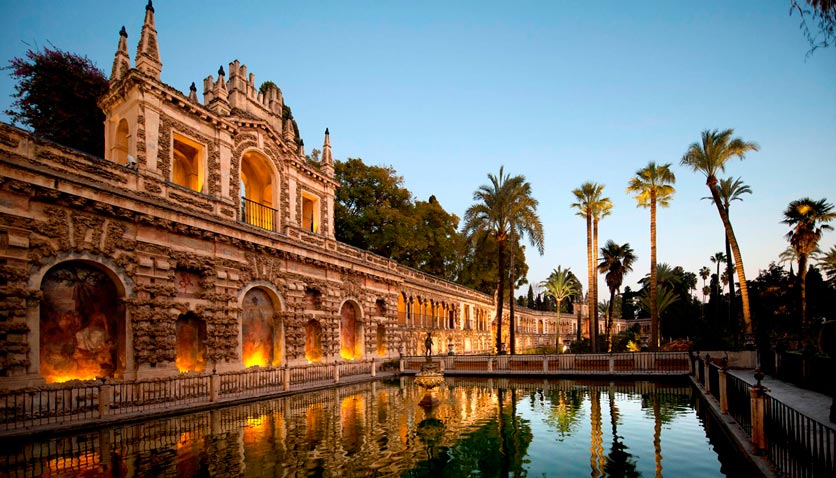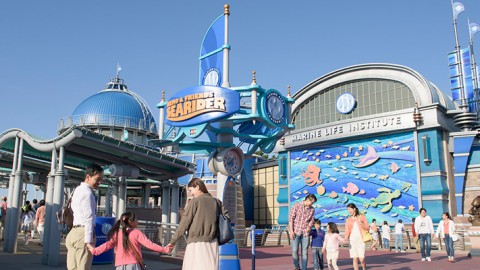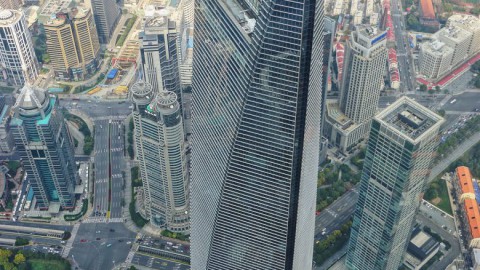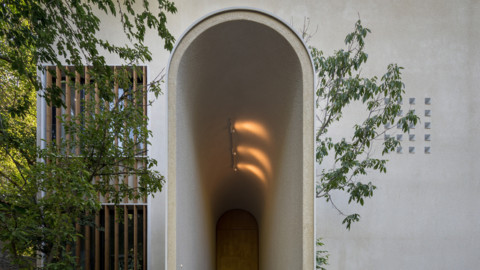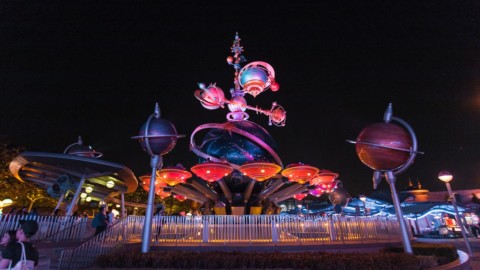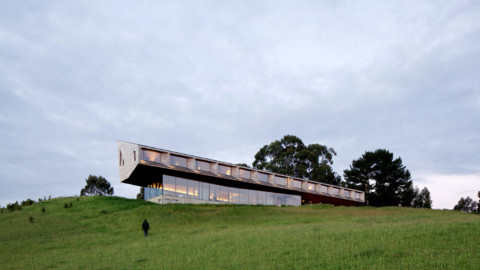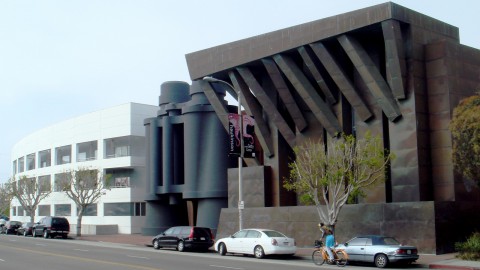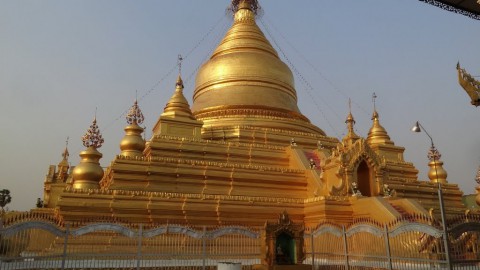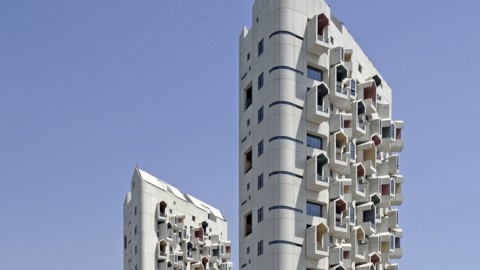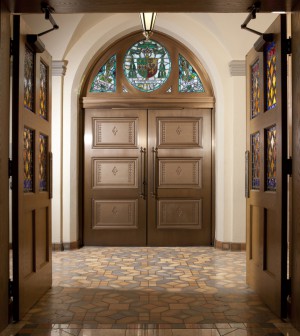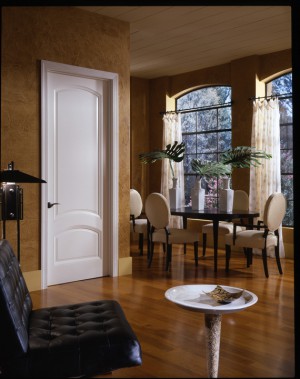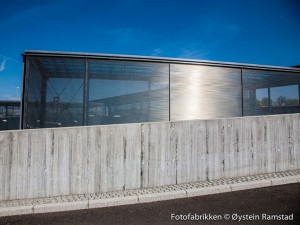Real Alcázar 塞維利亞王宮

The Alcázar of Seville (pronounced [alˈkaθaɾ]; Spanish: Reales Alcázares de Sevilla or “Royal Alcazars of Seville”) is a royal palace in Seville, Spain, built for the Christian king Peter of Castile. It was built by Castilian Christians on the site of an Abbadid Muslim residential fortress destroyed after the Christian conquest of Seville.Although some elements of other civilizations remains. The palace, a preeminent example of Mudéjar architecture in the Iberian Peninsula, is renowned as one of the most beautiful. The upper levels of the Alcázar are still used by the royal family as their official residence in Seville, and are administered by the Patrimonio Nacional. It is the oldest royal palace still in use in Europe, and was registered in 1987 by UNESCO as a World Heritage Site, along with the adjoining Seville Cathedral and the General Archive of the Indies.
塞維利亞的Alcázar(發音為[alkaθaɾ];西班牙語:RealesAlcázaresdeSevilla或“塞維利亞的皇家Alcazars”)是西班牙塞維利亞的皇宮,為基督教國王彼得·卡斯蒂利亞而建。 它是由卡斯蒂利亞基督徒在基督徒征服塞維利亞後被摧毀的Abbadid穆斯林住宅堡壘建造的。儘管其他文明的某些元素仍然存在。 宮殿是伊比利亞半島Mudéjar建築的傑出典範,是最美麗的宮殿之一。 Alcázar的上層仍然被王室用作他們在塞維利亞的官邸,由Patrimonio Nacional管理。 它是歐洲仍在使用的最古老的皇宮,於1987年被聯合國教科文組織列為世界遺產,以及毗鄰的塞維利亞大教堂和印度的一般檔案館。
Location:Seville, Spain
Part of:Cathedral, Alcázar and General Archive of the Indies in Seville
Criteria:Cultural: i, ii, iii, vi
Reference:383-002
Inscription:1987 (11th Session)
Coordinates:37°23′02″N 5°59′29″W
地點:西班牙塞維利亞
部分:塞維利亞的大教堂,阿爾卡薩和印度的一般檔案館
標準:文化:i,ii,iii,vi
參考:383-002
銘文:1987年(第11屆)
坐標:37°23’02“N 5°59’29”W
History
The Real Alcázar is situated near the Cathedral and the General Archive of the Indies in one of Andalusia’s most emblematic areas. This plot was occupied from the 8th century BC. In the 1st century AD the collegium (College of Olearians) was built. The early Visigothic Christian basilica of Saint Vincent was built on its ruins. For the construction of the Palace of Peter of Castile some shafts and capitals of this building were reused, the only Visigothic vestige that has survived to this day. The tombstone of the bishop Honorato, which was probably in this church, is currently in the cathedral.
Seville was conquered by the Umayyad caliphate in the year 712. At that time the basilica was demolished to build the first military work. It seems that it was a quadrangular enclosure, fortified, and annexed to the walls. During the period of the first Taifa kingdoms, various constructions were carried out, such as stables and warehouses, which should not have altered the building as a whole. The citadel began to gain importance in the first half of the 12th century, under the Abbadid dynasty, when the space doubled due to the construction of a large palace called Al-Muwarak, under the current Patio de la Monteria, of which only some archaeological remains are preserved.
Under the Almohads, during the caliphate of Abu Yusuf Yaqub al-Mansur, new buildings for the residence of the Caliph and his court were erected. With the exception of the walls, the previous buildings were demolished, and were carried out up to a total of twelve palaces. In the place where the Patio de la Montería is located, on the foundations of the Abbadid palace, a large building was built, which seems to be organized around a patio that followed the same scheme of the courtyard of the Aljafería of Zaragoza. Today, a sabat, or private passage, remains next to the south façade of the cathedral, which coincides with the Quibla wall of the mosque; this access allowed the caliph to reach the Macsura to avoid any danger. That palace had its royal room. A small courtyard, the Patio del Yeso, served as the residence of Pedro I in 1358 before the construction of his new palace; in spite of several restorations it is the most significant preserved space of the Almohad alcázar.
The rest of the architecture of the palace, which includes its most flamboyant parts, covers almost the whole set built by Alfonso X of Castile and Peter of Castile, with Mudéjar, Gothic and Mannerist halls and courtyards.
Some gardens have Renaissance statues. After damage by the 1755 Lisbon earthquake, that façade of the Palacio Gótico overlooking the Patio del Crucero was completely renovated in Baroque style.
The palace was the birthplace of Infanta Maria Antonietta of Spain (1729-1785), daughter of Philip V of Spain and Elisabeth Farnese, when the king was in the city to oversee the signing of the Treaty of Seville (1729) which ended the Anglo-Spanish War (1727).
歷史
RealAlcázar酒店位於安達盧西亞最具標誌性的地區之一,靠近大教堂和印度的一般檔案館。這個地塊佔據了公元前8世紀。公元1世紀,學院(Olearians學院)成立。聖文森特的早期西哥特基督教教堂建於廢墟上。為了建造卡斯蒂利亞的彼得宮,這座建築的一些豎井和首都被重複使用,這是迄今為止倖存下來的唯一的西哥特遺跡。 Honorato主教的墓碑,可能在這個教堂裡,目前在大教堂裡。
塞維利亞在712年被Umayyad哈里發征服。那時,大教堂被拆除以建造第一個軍事工作。它似乎是一個四邊形的圍牆,加固並附在牆上。在第一個泰法王國時期,進行了各種建築,如馬厩和倉庫,這些建築不應該改變整個建築。城堡在12世紀上半葉開始變得越來越重要,在Abbadid王朝時期,由於在當前的Patio de la Monteria建造了一座名為Al-Muwarak的大型宮殿,其空間翻了一番,其中只有一些考古學遺體保存完好。
根據Almohads,在Abu Yusuf Yaqub al-Mansur的哈里發期間,建立了哈里發居住的新建築物及其法院。除了牆壁之外,以前的建築物被拆除,並且共進行了十二個宮殿。在Patio delaMontería所在的地方,在Abbadid宮殿的基礎上,建造了一座大型建築,似乎圍繞著一個庭院,沿著薩拉戈薩Aljafería庭院的相同方案。今天,大教堂的南立面旁邊還有一條sabat或私人通道,與清真寺的Quibla牆相吻合;這種訪問允許哈里發到達Macsura以避免任何危險。那座宮殿有皇室。 Patio del Yeso小庭院於1358年作為Pedro I的住所,在建造新宮殿之前;儘管有幾處修復,但它仍是Almohadalcázar最重要的保存空間。
宮殿的其他建築,包括其最華麗的部分,幾乎涵蓋了卡斯蒂利亞的阿方索十世和卡斯蒂利亞的彼得建造的整套,與穆德哈爾,哥特和風格的大廳和庭院。
有些花園裡有文藝復興時期的雕像。經過1755年里斯本地震的破壞,俯瞰Patio del Crucero的PalacioGótico外牆經過巴洛克風格的全面翻新。
這座宮殿是西班牙的Infanta Maria Antonietta(1729-1785)的出生地,是西班牙菲利普五世的女兒和伊麗莎白法納斯,當時國王在該市監督簽署塞維利亞條約(1729年),該條約結束了盎格魯 – 西班牙戰爭(1727年)。



The Palace 宮殿
Puerta del León
The main entrance to the Alcázar takes its name from the 19th century tile-work inlaid above it, a crowned lion holding a cross in its claws and bearing a Gothic script.
PuertadelLeón
阿爾卡薩(Alcázar)的主要入口取名於19世紀鑲嵌在它上面的瓷磚上面,這是一隻加冠的獅子,它的爪子上有一個十字架,上面刻有哥特式的字體。
Patio de las Doncellas
The name, meaning “The Courtyard of the Maidens”, refers to the legend that the Moors demanded 100 virgins every year as tribute from Christian kingdoms in Iberia.
The lower level of the Patio was built for King Peter of Castile and includes inscriptions describing Peter as a “sultan”. Various lavish reception rooms are located on the sides of the Patio. In the center is a large, rectangular reflecting pool with sunken gardens on either side. For many years, the courtyard was entirely paved in marble with a fountain in the center. However, historical evidence showed the gardens and the reflecting pool were the original design and this arrangement was restored. However, soon after this restoration, the courtyard was temporarily paved with marble once again at the request of movie director Ridley Scott. Scott used the paved courtyard as the set for the court of the King of Jerusalem in his movie Kingdom of Heaven. The courtyard arrangement was converted once more after the movie’s production.
The upper story of the Patio was an addition made by Charles V. The addition was designed by Luis de Vega in the style of the Italian Renaissance although he did include both Renaissance and mudéjar plaster work in the decorations. Construction of the addition began in 1540 and ended in 1572.
Patio de las Doncellas
這個名字,意思是“少女的庭院”,指的是摩爾人每年要求100名處女作為伊比利亞基督教王國的致敬的傳說。
天井的較低層是為卡斯蒂利亞國王彼得建造的,其中包括將彼得描述為“蘇丹”的銘文。 Patio酒店兩側設有各種豪華的接待室。中心是一個大型矩形反射池,兩側都有下沉式花園。多年來,庭院完全鋪成大理石,中間有一個噴泉。然而,歷史證據表明,花園和反射池是原始設計,這種安排得到了恢復。然而,在這次修復後不久,應電影導演雷德利·斯科特的要求,庭院再次被大理石鋪設。斯科特在他的電影“天國”中使用鋪好的庭院作為耶路撒冷國王宮廷的場景。在電影製作完成後,庭院安排再次轉換。
天井的上層建築是查理五世的新成員。此外,Luis de Vega以意大利文藝復興風格設計了這個項目,儘管他在裝飾中確實包含了文藝復興時期和泥濘的石膏作品。建築的增建始於1540年,並於1572年結束。
Los Baños de Doña María de Padilla
The “Baths of Lady María de Padilla” are rainwater tanks beneath the Patio del Crucero. The tanks are named after María de Padilla, the mistress of Peter the Cruel.
LosBañosdeDoñaMaríadePadilla
“MaríadePadilla女士浴場”是Patio del Crucero下方的雨水箱。坦克以彼得殘酷的情婦瑪麗亞德帕迪拉命名。
Salon de Embajadores
The Salon de Embajadores, meaning The Ambassadors Reception Room”, was the main room that King Peter of Castile used for his stay at the Alcazar. This room was the most richly decorated within the entire Alcazar Palace, which was in keeping with its role of power. In 1526, Emperor Charles V and Isabella of Portugal celebrated their marriage in this room.
Salon de Embajadores
Salon de Embajadores,意思是“大使接待室”,是卡斯蒂利亞國王彼得在Alcazar逗留期間使用的主要房間。這個房間是整個阿爾卡薩宮內裝飾最豐富的房間,與其角色一致。 1526年,皇帝查理五世和葡萄牙的伊莎貝拉在這個房間慶祝他們的婚姻。


FROM:https://en.wikipedia.org/wiki/Alc%C3%A1zar_of_Seville
FROM:Royal Alcazar of Seville – Spain 4K Travel Channel
FROM:Spain Alcazar, Royal Palace in Seville, So Beautiful!
Don’t you think it’s addictive?
Want to know more about the beauty of architecture?
Come and join our members to explore the beauty of architectural design.
覺得看得不過癮嗎?
想要知道更多建築之美嗎?
快來加入我們的會員,一同探索建築設計之美。
The above article is purely for appreciation and sharing purposes, as well as the construction of new technology and the public can be in-depth understanding of the information at the same time there are sources, will be able to query, no use of the document as a commercial transaction, if illegal, please inform the We will immediately remove the site, thank you for cooperation.
以上文章純粹作為欣賞及分享用途,以及將建築新型技術傳遞給與大眾能夠深入了解,同時資料還有來源,將可查詢,絕無使用該文件資料作為商業交易行為,如有違法請務必告知該網站我們將立即處理撤除,謝謝合作。

